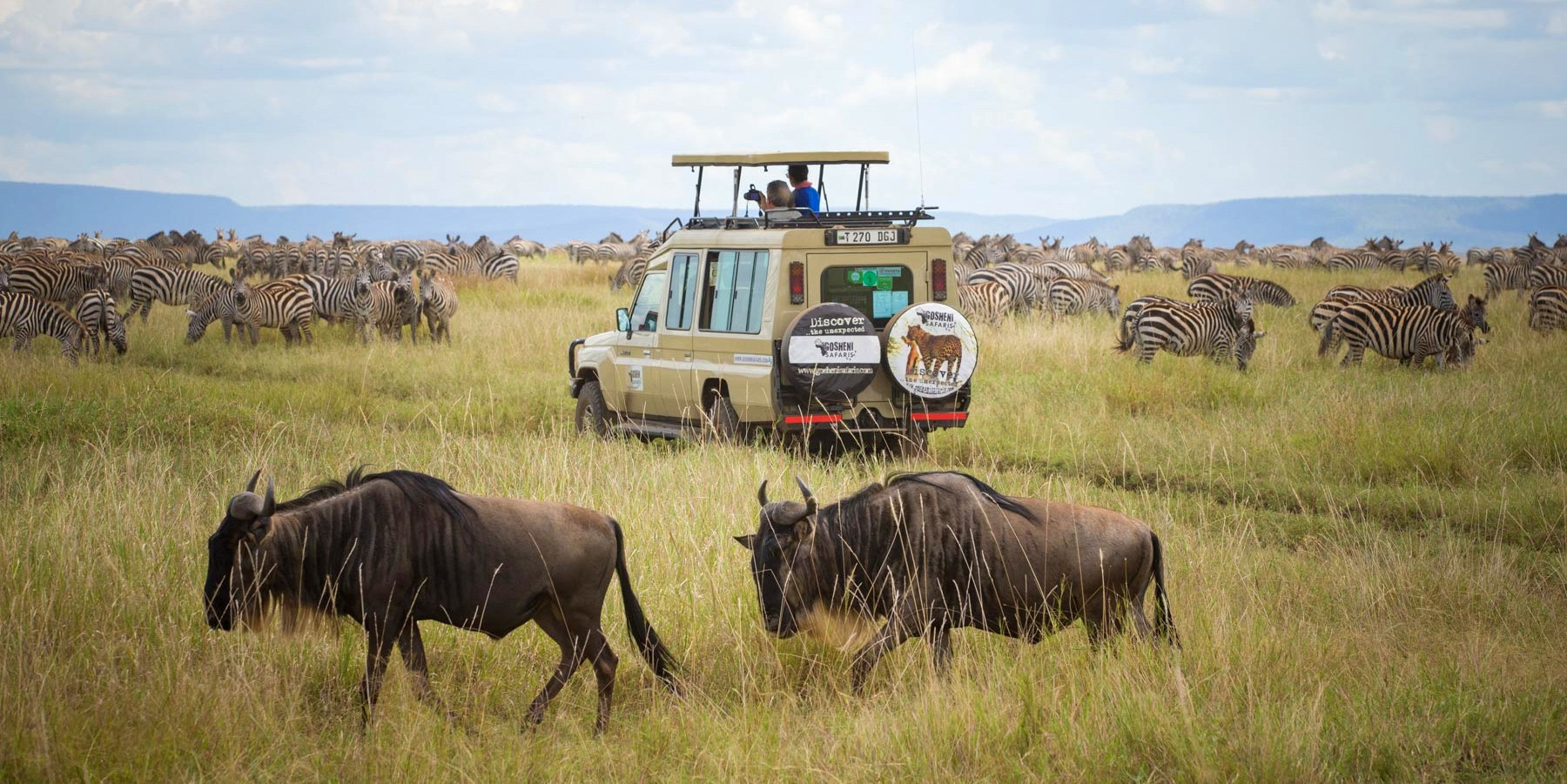Serengeti National Park Safari
Serengeti National Park Safari is one of the most iconic and sought-after safari experiences globally. Located in northern Tanzania, the Serengeti is famed for its vast, open landscapes and its role as the setting for one of the natural world’s most impressive events: the annual Great Migration. Here’s what makes a safari in Serengeti National Park truly exceptional:
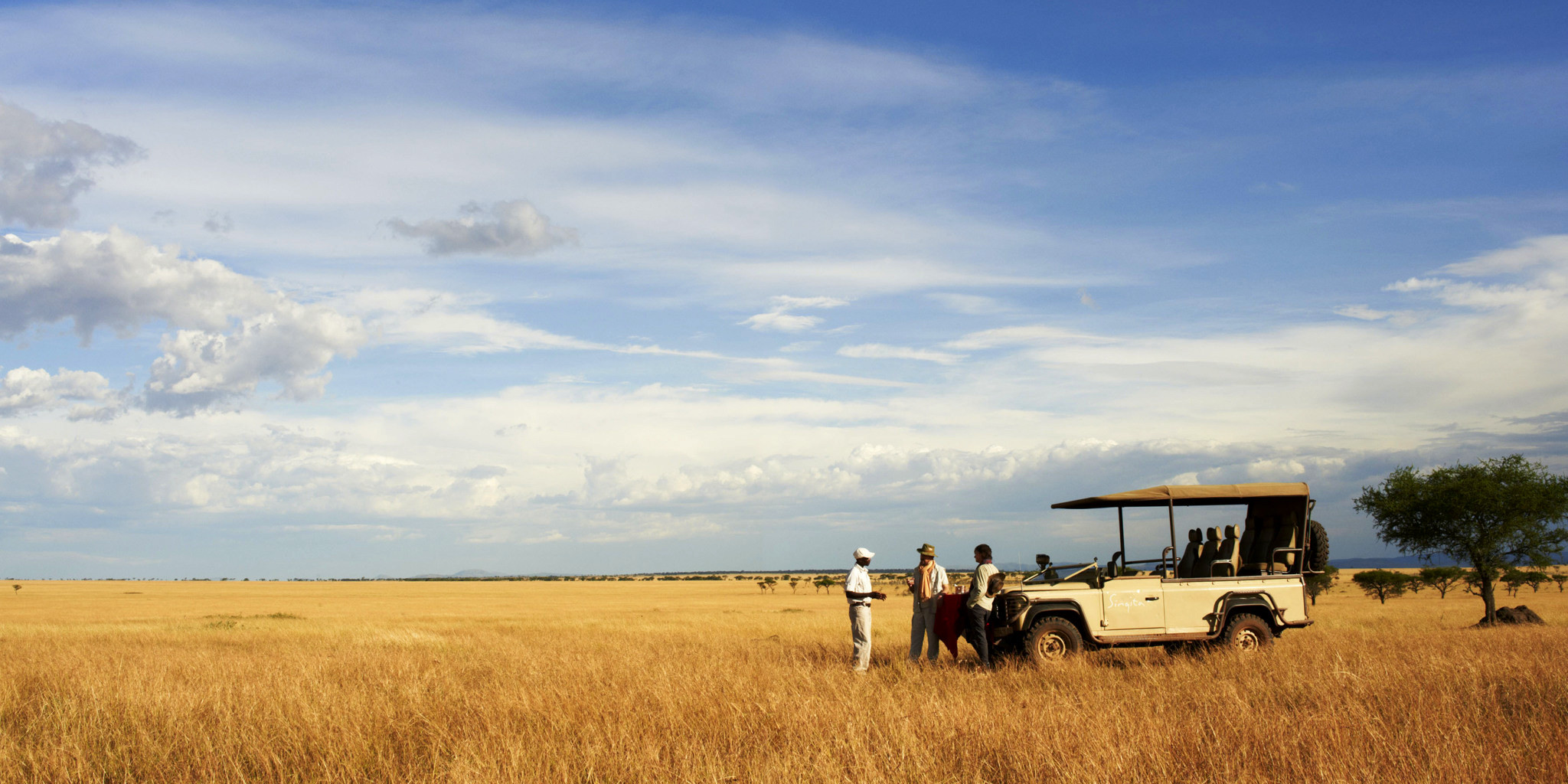
-
The Great Migration: Perhaps the most compelling attraction in the Serengeti is the Great Migration, where over 1.5 million wildebeest, hundreds of thousands of zebras, and several other species of hoofed animals move across the plains in an endless cycle of birth, death, and rebirth. This spectacle is considered one of the ten natural travel wonders of the world, offering dramatic scenes as the herds cross crocodile-infested waters and predatory zones.
-
Diverse Wildlife: Aside from the migratory species, the Serengeti is an excellent place for viewing the Big Five (lion, leopard, rhinoceros, elephant, and buffalo). The park is particularly renowned for its lion population—the largest in Africa—and offers some of the best chances of witnessing a leopard in the wild. Cheetahs, hyenas, giraffes, and a vast array of other animals also inhabit this vibrant ecosystem.
-
Birdwatching: With more than 500 bird species, the Serengeti is a paradise for birdwatchers. From the outrageously colored lilac-breasted roller to larger birds like ostriches and Kori bustards, the diversity is staggering. Seasonal European and Asian migrants also visit, adding to the park's rich aviary population.
-
Scenic Landscapes: The park spans approximately 14,750 square kilometers and offers some of the most breathtaking landscapes in Africa, characterized by vast plains, rolling hills, and rocky outcrops known as kopjes. These natural structures are often used as lookout points by predators and are iconic to the Serengeti’s landscape.
-
Cultural Experiences: Visitors can also engage with local Maasai communities living around the Serengeti. Many safaris offer cultural tours or interactions, allowing visitors to learn about the Maasai's traditional ways of life, including their unique customs, dances, and crafts.
-
Variety of Safari Activities: Serengeti offers various ways to explore its beauty, from classic game drives and walking safaris to hot-air balloon safaris that provide an aerial view of the sprawling landscape. Night drives are also an option in certain areas, offering a glimpse into the nocturnal activities of the park’s inhabitants.
-
Accommodations: There is a wide range of accommodations available, from luxury lodges and tented camps to more modest campsites. Many are strategically located to offer the best access to game viewing areas and to maximize the chances of seeing the migration unfold.
-
Sustainable Tourism: The park is also a leader in conservation efforts, working towards sustainable tourism practices that help preserve its unique ecosystem for future generations.
A Serengeti National Park Safari is not just a trip; it's an immersive experience that brings you face-to-face with the rawness and beauty of nature. Whether it’s your first safari or a return visit, the Serengeti promises an unforgettable adventure with new sights, sounds, and discoveries each time.
Ngorongoro Crater Safari
The Ngorongoro Crater Safari offers an unparalleled safari experience in one of the world's most unique wildlife destinations. Located in northern Tanzania, the Ngorongoro Crater is a UNESCO World Heritage site and the largest intact volcanic caldera on the planet. Here's why a safari in the Ngorongoro Crater stands out as a must-visit for wildlife enthusiasts and nature lovers:
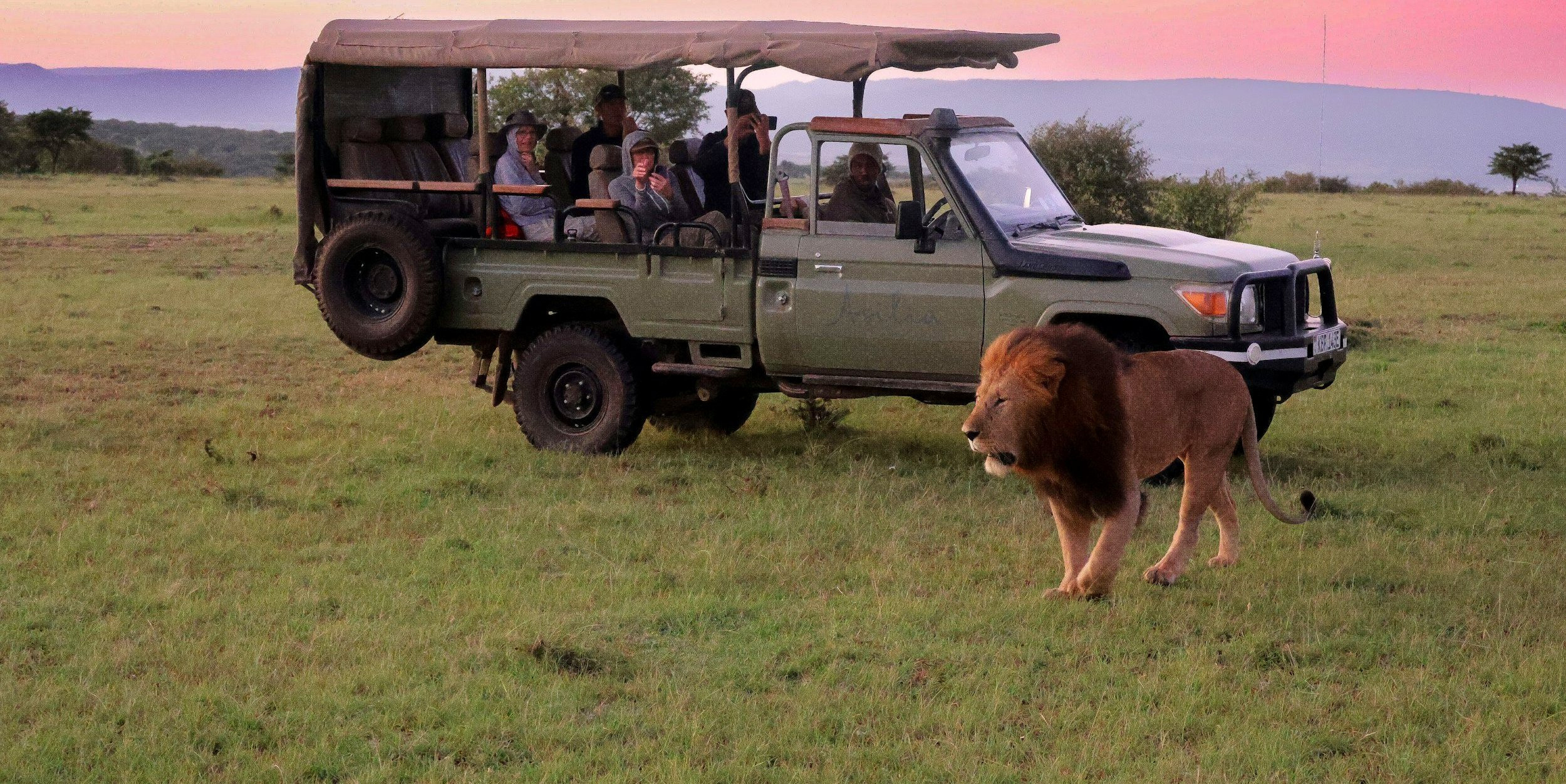
-
Breathtaking Natural Setting: The Ngorongoro Crater was formed when a giant volcano exploded and collapsed on itself two to three million years ago. The crater floor, now a vast bowl covering 260 square kilometers, is a natural enclosure for a wide variety of wildlife. The high walls of the crater create a dramatic backdrop and help to maintain a relatively self-contained ecosystem.
-
Exceptional Wildlife Viewing: The crater is famously known as a "garden of Eden" due to its dense population of wildlife, including some of the highest densities of lions in the world. It is one of the few places in Tanzania where you can see the Big Five (lion, leopard, rhinoceros, elephant, and buffalo) in one day. The endangered black rhino can also be spotted here, making it a particularly special location for wildlife sightings.
-
Birdlife: For bird enthusiasts, the Ngorongoro Crater does not disappoint. It hosts over 500 bird species, offering a fantastic opportunity for birdwatching. The crater's lakes attract flamingos and other water birds, while the forests and grasslands are home to many raptors and other species.
-
Year-Round Accessibility: Unlike some parts of Tanzania that have peak seasons, the Ngorongoro Crater offers excellent game viewing opportunities year-round. The consistent presence of animals within the crater walls means that visitors are almost guaranteed to witness spectacular wildlife at any time of the year.
-
Cultural Interactions: The crater area is also culturally significant, inhabited by the Maasai people who graze their livestock alongside the wild animals. Many safari tours offer visits to Maasai villages, providing an insight into the traditional lifestyles and customs of one of Tanzania’s most famous indigenous tribes.
-
Conservation Efforts: The Ngorongoro Conservation Area is not only a natural reserve but also a pioneering experiment in multiple land use where human habitation and wildlife coexist. The conservation strategies here are aimed at preserving the natural environment while supporting the sustainable development of local communities.
-
Luxurious Accommodations: Around the rim of the crater and in the wider Ngorongoro Conservation Area, there are several high-end lodges and campsites designed to maximize the views and the visitor experience while emphasizing environmental sensitivity.
-
Unique Activities:In addition to traditional game drives, visitors to the Ngorongoro Crater can engage in walking safaris led by experienced guides, providing a more intimate encounter with the nature and wildlife of the area. Some tours also offer opportunities for picnicking within the crater, providing a memorable dining experience amidst one of Africa’s most stunning landscapes.
A Ngorongoro Crater Safari is an essential part of any Tanzanian adventure, offering a blend of breathtaking natural beauty, extraordinary wildlife encounters, and rich cultural interactions, all within the confines of a geological marvel. Whether you are a first-time visitor to Africa or a seasoned safari enthusiast, the Ngorongoro Crater promises a truly unforgettable experience.
Tarangire National Park
Tarangire National Park is a remarkable and somewhat underrated gem in Tanzania’s northern safari circuit. Known for its large herds of elephants and majestic baobab trees, this park offers a distinctive safari experience that contrasts with its more famous neighbors like the Serengeti and the Ngorongoro Crater. Here’s what makes Tarangire National Park a standout destination for visitors:
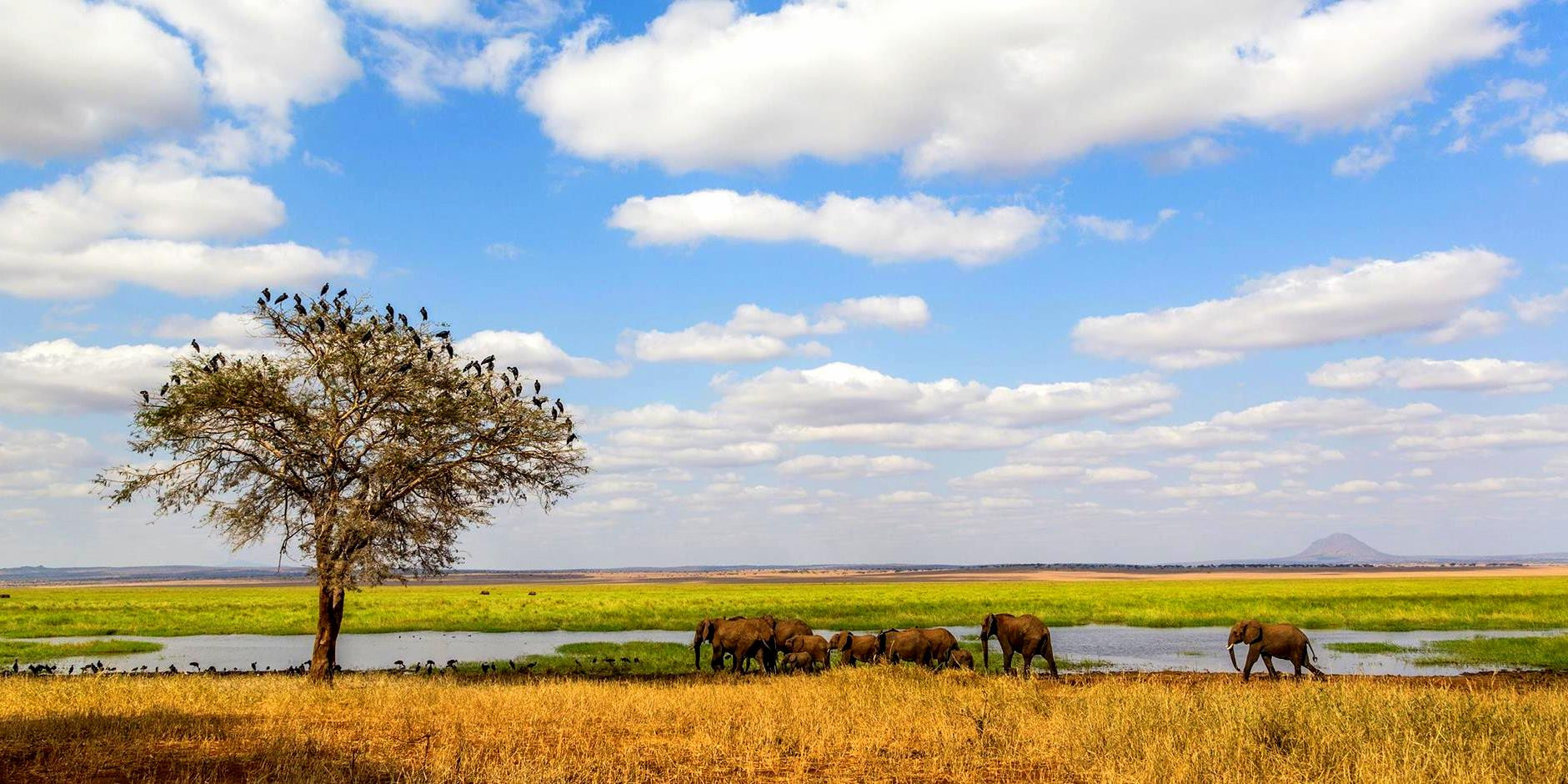
-
Elephant Population: Tarangire is famed for its thriving elephant population. Visitors are often treated to close-up views of these majestic creatures, with herds sometimes numbering into the hundreds. The dry season, particularly from June to October, sees these herds congregating around the Tarangire River, making for spectacular wildlife watching.
-
Scenic Landscapes: The landscape of Tarangire is diverse and visually stunning, characterized by granitic ridges, river valleys, and extensive wetlands. It is also dotted with iconic baobab trees, which provide dramatic silhouettes against the African sky. These trees are centuries-old and serve as natural water reservoirs, essential for the wildlife during the dry periods.
-
Bird Watching: With over 550 bird species recorded, Tarangire is a paradise for birdwatchers. The park’s varied habitats support a fascinating variety of birds, including dry-country endemics not commonly seen elsewhere in northern Tanzania. The swamps, tinged with green year-round, attract the largest selection of breeding birds anywhere in the world, from the dazzling yellow-collared lovebird to the towering kori bustard.
-
Less Crowded: Compared to the Serengeti and Ngorongoro, Tarangire National Park tends to be less crowded. This makes it an excellent choice for those who prefer a more serene safari experience, allowing for leisurely game viewing without the interruption of numerous other vehicles.
-
Diverse Wildlife: Besides elephants, the park is home to many other animals including lions, leopards, wildebeest, zebras, and buffalo. During the dry season, these animals and many more are drawn to the Tarangire River, the park’s only permanent water source. The park is also one of the only places in Tanzania where dry-country antelope such as the stately fringe-eared oryx and peculiar long-necked gerenuk are regularly observed.
-
Walking Safaris and Cultural Tours: For those looking to stretch their legs, Tarangire offers guided walking safaris that provide an intimate bush experience. Additionally, cultural tours to nearby Maasai and Barabaig villages offer insights into the traditional lifestyles of the local tribes, enhancing the visitor experience with a cultural perspective.
-
Accessibility and Accommodations: Located just a few hours drive from Arusha and close to the route that connects Manyara, Ngorongoro, and the Serengeti, Tarangire is easily accessible for safari-goers. The park offers a range of accommodations, from luxury lodges to basic campsites, catering to all preferences and budgets.
A visit to Tarangire National Park is not just about observing wildlife but is a holistic nature experience. With its serene environment, diverse wildlife, and stunning landscapes, Tarangire provides a unique and memorable safari experience that complements the more frequented parks of Tanzania’s northern circuit.
Selous Game Reserve
Selous Game Reserve, officially known as the Nyerere National Park since 2019, is one of the largest faunal reserves in the world and a celebrated part of Tanzania’s southern safari circuit. This reserve offers a distinctly different experience from the northern circuit parks like the Serengeti or Ngorongoro. Here’s why Selous Game Reserve stands out as a must-visit for safari enthusiasts:
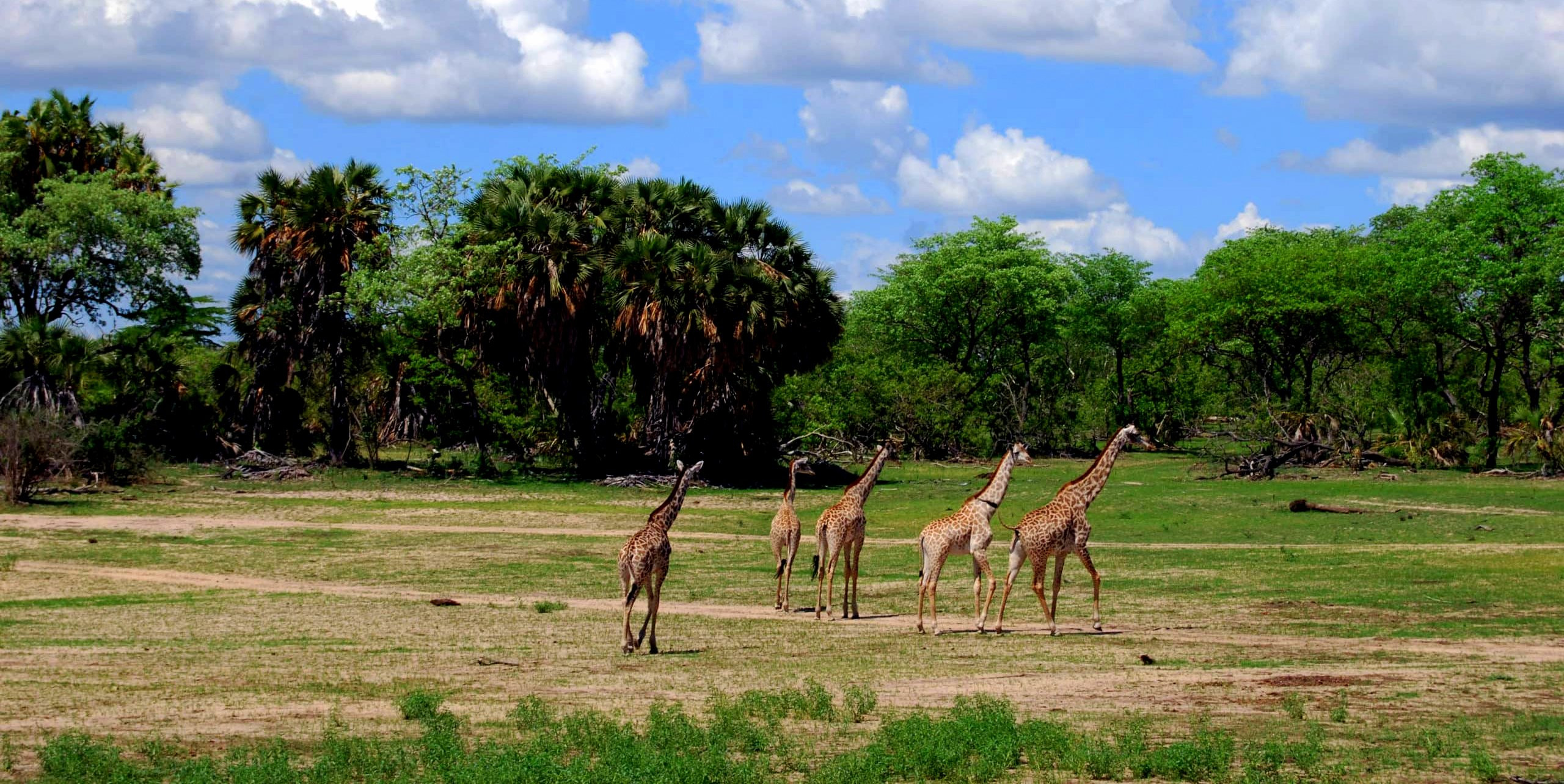
-
Vast and Untouched Wilderness: Covering over 30,000 square kilometers, Selous is one of the largest protected areas in Africa, offering a vast, unspoiled wilderness. This site and the park’s remote location mean that it remains one of the least disturbed natural habitats in Tanzania. Visitors to Selous enjoy the feeling of exploring an untouched land.
-
Rich Biodiversity: Despite recent name changes and a portion being designated as a national park, the area still maintains a rich biodiversity. It is home to large numbers of elephants, wild dogs, buffalos, hippos, crocodiles, and fantastic bird life. The reserve is also one of the best places in Africa to witness packs of African wild dogs.
-
Varied Safari Activities: Selous offers a diverse range of safari activities. In addition to traditional game drives, visitors can explore the Rufiji River by boat, providing a unique perspective on the wildlife that comes to the water, especially during the dry season. Walking safaris are also highly popular in Selous, offering an intimate and thrilling encounter with the African bush.
-
Bird Watching: The reserve is a haven for bird watchers, with over 440 bird species recorded. The varying landscapes from open grasslands to dense forests and the riverine habitat offer abundant opportunities to see both resident and migratory bird species.
-
Photographic Opportunities: With its diverse landscapes, ranging from dry savannah to wetlands and dense forests, along with the rich wildlife, Selous is a photographer’s paradise. The less commercial aspect of the reserve means you can take your time to set up the perfect wildlife shots without the pressure of crowded sighting spots.
-
Luxury Accommodations: Despite its remote nature, Selous hosts a range of luxury lodges and tented camps. These accommodations provide comfort and exclusivity, often situated along the riverbanks, offering stunning views and the soothing sounds of the African wilderness.
-
Cultural Interactions: For those interested in cultural experiences, visits to local villages surrounding the reserve can be arranged. These interactions provide insight into the lifestyles of indigenous communities and their relationship with the natural environment.
-
Conservation Efforts: The reserve is a significant focus of various conservation efforts aimed at protecting its vast ecosystems and combating poaching. Supporting tourism here contributes to these conservation initiatives, helping to ensure the survival of the area's unique wildlife.
Selous Game Reserve offers a safari experience that is both adventurous and serene, making it ideal for those looking to escape the more frequented tourist routes and immerse themselves in the wild heart of Africa. Its unique blend of landscapes and wildlife, coupled with the array of safari activities, makes Selous a compelling destination for any safari-goer.
Ruaha National Park
Ruaha National Park is one of Tanzania’s true hidden gems, known for its raw and rugged wilderness. As the largest national park in Tanzania, Ruaha provides a spectacular and less-traveled alternative for those looking to immerse themselves in an intense safari experience. Here’s what makes Ruaha National Park a standout destination in the Tanzanian safari circuit:
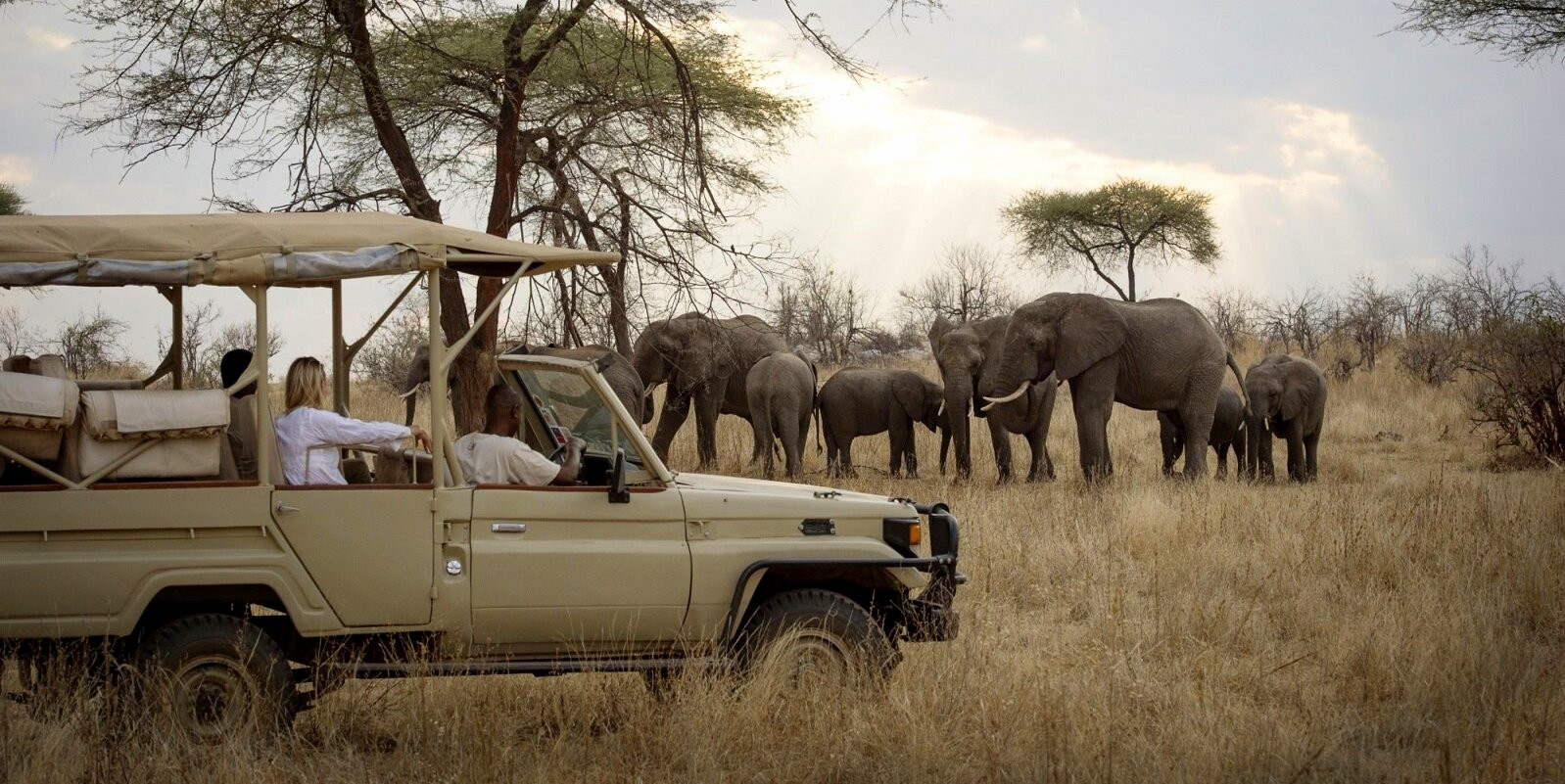
-
Expansive Wilderness: Ruaha’s vast landscape spans about 20,000 square kilometers, offering a dramatic and largely unexplored terrain. The park’s size and relative obscurity mean that visitors can enjoy a more private and exclusive safari experience, often without encountering other tourists.
-
Diverse Habitats: The park is characterized by its diverse ecosystems, which include rolling hills, large open plains, and the great Ruaha River. This variety of landscapes supports an impressive range of flora and fauna, creating dynamic and beautiful scenery that changes with the seasons.
-
Rich Biodiversity: Ruaha is known for its high concentration of elephants, boasting one of the largest populations of any African park. It is also home to robust population of buffaloes, lions, cheetahs, leopards, and wild dogs. The park’s unique position at the confluence of eastern and southern African eco-zones makes it a hotspot for biodiversity, including a mix of species that are rare or absent in northern Tanzania.
-
Bird Watching: With more than 570 species of birds documented, Ruaha is a paradise for bird watchers. Its diverse habitats attract a wide array of birdlife, including both resident and migratory species, making it one of the premier birding destinations in the region.
-
Predator Sightings: Ruaha is particularly noted for its large populations of predators. It offers some of the best opportunities to observe lions, cheetahs, leopards, and the increasingly rare African wild dogs in their natural habitats.
-
Walking Safaris: One of the distinctive features of Ruaha is the opportunity to participate in walking safaris. These on-foot adventures allow guests to experience the African bush from a different perspective, learning about the smaller ecosystems and tracking animals with experienced guides.
-
Cultural Experiences: Visitors to Ruaha can also engage with local communities, such as the Hehe and Maasai people, learning about their cultures and traditional ways of life. These cultural tours provide a deeper understanding of the human history and current social dynamics of the region.
-
Accommodations: Accommodation in Ruaha ranges from basic fly-camping setups to luxurious lodges. The lodges are often small and intimate, providing an upscale and personalized safari experience that emphasizes environmental sustainability.
-
Conservation Efforts: Ruaha is at the forefront of several conservation initiatives, particularly efforts to protect elephants and combat poaching. The park’s management works closely with local communities and conservation organizations to sustain its wildlife and habitats.
Ruaha National Park offers a distinctly authentic safari experience, where visitors can delve deep into one of Africa’s most intense wildernesses. Its combination of solitude, scenic beauty, and rich biodiversity makes Ruaha an ideal destination for those seeking adventure and a deep connection with nature.
Lake Manyara National Park
Lake Manyara National Park is a scenic wildlife haven located in the northern part of Tanzania, renowned for its stunning landscapes, diverse ecosystems, and unique wildlife. Despite being one of Tanzania’s smaller national parks, Lake Manyara offers a dense biodiversity and a range of activities that make it a must-visit destination on any Tanzanian safari itinerary. Here’s why Lake Manyara stands out:
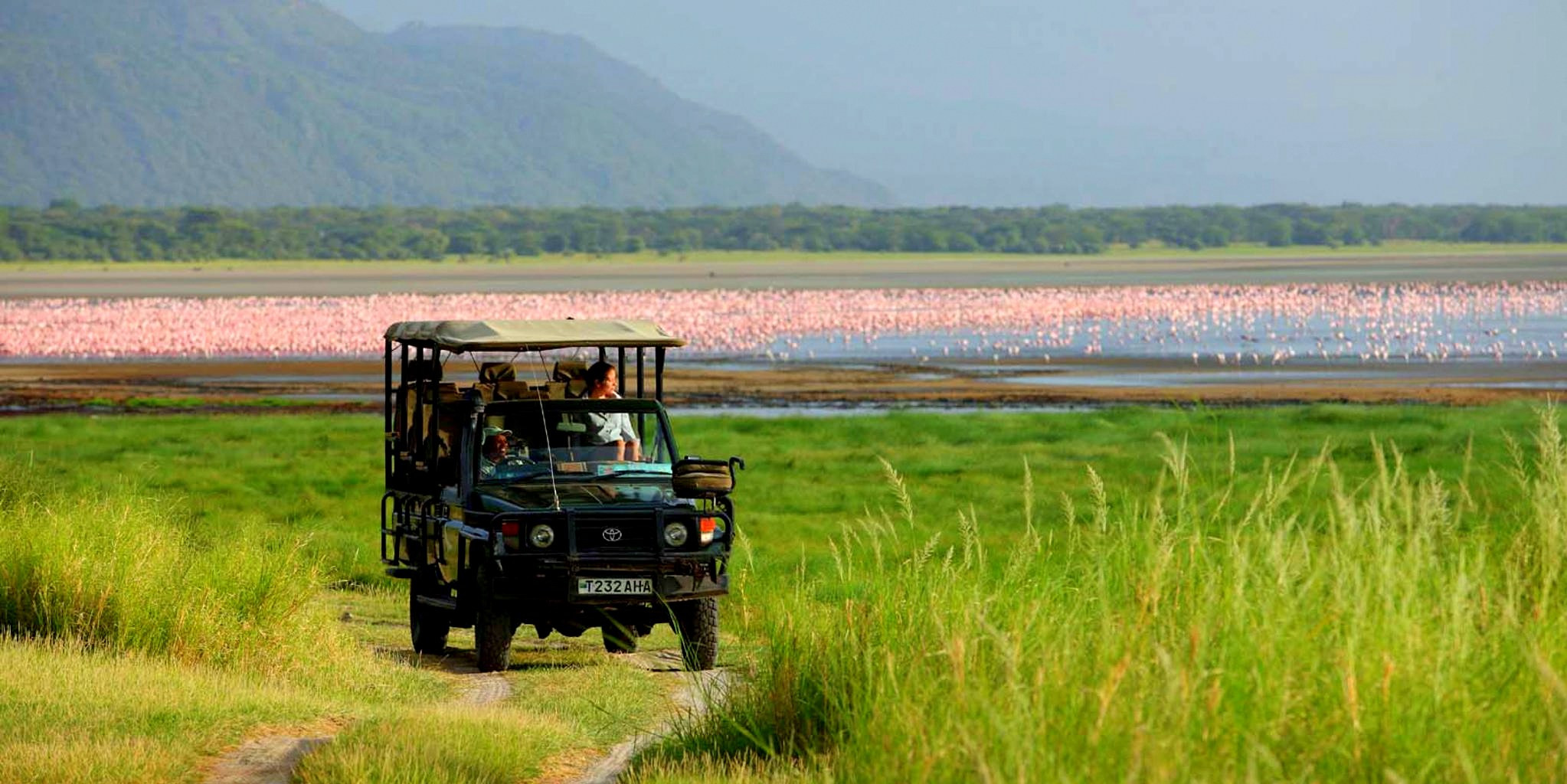
-
Diverse Landscapes: Lake Manyara National Park features a wide array of environments, from its alkaline lake to dense woodlands and steep mountainsides. The park's most famous landmark, Lake Manyara itself, is a shallow alkaline lake that covers as much as 200 square kilometers of the park during the wet season. These varied habitats support an equally diverse array of wildlife and offer breathtaking scenic views.
-
Tree-Climbing Lions: One of the park's main attractions is its population of tree-climbing lions. While lions are generally not known for climbing trees, the lions in Lake Manyara often escape the heat and bugs by resting in the branches of trees. Catching a glimpse of these majestic animals lounging in an acacia tree is a unique and unforgettable sight.
-
Rich Birdlife: Lake Manyara is a paradise for bird enthusiasts, with over 400 species recorded. The park is particularly famous for its flocks of thousands of flamingos that feed along the lake in the wet season. In addition to flamingos, visitors can see pelicans, storks, kingfishers, cormorants, and the rarer ground hornbill and crested eagle.
-
Wildlife Diversity: Besides the famous lions, the park is home to the largest concentration of baboons anywhere in the world, which provides for some interesting wildlife interactions. Other animals frequently seen in the park include elephants, zebras, giraffes, buffaloes, hippos, and a variety of antelope species.
-
Elephant Populations: The forests of Lake Manyara are ideal for viewing elephant families up close. The park’s elephants are known for being more approachable than in other parks, allowing for exceptional photographic opportunities.
-
Cultural Tours: Visitors to Lake Manyara can also engage in cultural tours of nearby Maasai and other indigenous communities. These tours offer insights into the traditional ways of life and interactions that provide a deeper understanding of the local cultures.
-
Activities: In addition to game drives, Lake Manyara National Park offers night safaris, canoeing when the water levels are sufficiently high, mountain bike tours, and forest walks, providing different perspectives of the park’s environment and wildlife.
-
Accessibility: The park’s proximity to Arusha and the Ngorongoro Crater makes it an easy addition to any safari circuit in northern Tanzania. It is often visited as a day trip, but there are several lodges and campsites for those who wish to stay longer.
-
Conservation Efforts: Lake Manyara National Park is also involved in various conservation efforts, aiming to preserve the fragile ecosystems within its bounds and the wildlife that depends on them.
Lake Manyara National Park offers a compact but impactful safari experience, rich in wildlife viewing, beautiful landscapes, and cultural opportunities. Its accessibility and the variety of activities make it a versatile choice for both first-time safari-goers and seasoned travelers.
Tips for Best Tanzania Safari Tours
Planning a safari in Tanzania can be a thrilling yet daunting task, especially with so many incredible destinations and experiences to choose from. To help you get the most out of your adventure, here are some essential tips for organizing the Best Tanzania Safari Tours:
-
Choose the Right Time to Visit: Timing is crucial for a successful safari. The best general time to visit Tanzania for wildlife viewing is during the dry season from late June to October, when animals congregate around water sources. However, if you're interested in seeing the Great Migration in the Serengeti, the best months are typically from December to July, with the calving season in late January and February.
-
Consider Your Budget: Safaris can range from budget-friendly to ultra-luxurious. Decide how much you're willing to spend and look for a tour that matches your budget. Keep in mind that while budget options are cheaper, they might involve longer drives in crowded minibusses, whereas luxury safaris offer more exclusive experiences with greater comfort.
-
Book Through a Reputable Operator: Ensure you book your safari through a reputable tour operator. Reliable operators provide knowledgeable guides, quality accommodations, and safe transportation. Check reviews and ask for recommendations to ensure you choose a reputable provider.
-
Prepare for Varying Weather Conditions: Even during the dry season, nights and early mornings can be chilly, and the daytime can be very hot. Pack accordingly with layers of clothing, including a warm jacket and breathable fabrics.
-
Pack Essential Items: Bring binoculars, a good camera with a zoom lens, and plenty of memory cards. Sunscreen, a hat, and insect repellent are also essential. Don’t forget a sturdy pair of binoculars for better wildlife viewing.
-
Respect Wildlife and Local Customs: Follow your guide’s advice, keep a safe and respectful distance from the wildlife, and stay quiet during game drives. Also, be respectful of local customs and traditions, especially when visiting villages or interacting with local communities.
-
Consider Health Precautions: Consult with a travel doctor before departure to get necessary vaccinations and medications, such as malaria prophylaxis. Ensure you have comprehensive travel insurance that covers medical emergencies.
-
Stay Hydrated and Eat Well: Keep hydrated, especially during long game drives. Most safari packages include meals, so inform your tour operator of any dietary restrictions in advance.
-
Embrace the Entire Experience: While wildlife is a significant part of the safari, embrace everything from the stunning landscapes and sunsets to the bird songs and the night sky. A safari is an immersive experience; let the wonders of nature inspire you.
Following these tips can help ensure that your Tanzania safari is safe, enjoyable, and unforgettable. Whether you’re exploring the vast plains of the Serengeti or the rugged wilderness of Ruaha, Tanzania offers some of the most spectacular safari experiences in the world.
Best Time for Tanzania Safari Tours
Exploring Tanzania through its varying seasons can significantly influence your safari experience, as each season brings its own unique advantages and considerations. Here's a detailed guide on what to expect during each season in Tanzania:
Dry Season (June to October)
-
Wildlife Viewing: The dry season is the most popular time for safaris due to excellent wildlife viewing. Animals are easier to spot as they congregate around dwindling water sources.
-
Weather: The weather is generally dry and cool, especially in the early mornings and evenings. This makes for comfortable safari conditions.
-
Tourist Volume: This season is the peak tourist season, with July and August being the busiest months. You'll find that popular destinations like the Serengeti and Ngorongoro Crater can be quite crowded.
-
Activities: Ideal for game drives, walking safaris, and witnessing the Great Migration, especially the dramatic river crossings in the northern Serengeti (typically occurring between July and September).
Short Rains (November to December)
-
Wildlife Viewing: Wildlife viewing is still very good, and the landscape starts to rejuvenate, becoming beautifully green.
-
Weather: Expect short bursts of rain mostly in the afternoons or evenings, which generally won’t disrupt safari activities.
-
Tourist Volume: Fewer tourists travel during this period, so parks are less crowded, and rates may be lower.
-
Activities: Good conditions for game drives with fresh scenery and newborn animals. Bird watching begins to peak as migratory birds arrive.
Wet Season (March to May)
-
Wildlife Viewing: This is the least favorable time for traditional wildlife viewing due to thick vegetation and challenging driving conditions.
-
Weather: Known as the 'long rains', this period experiences more prolonged and heavier rainfall, which can lead to muddy conditions and some lodges and camps closing.
-
Tourist Volume: Tourist numbers are at their lowest, offering the most privacy and reduced rates at accommodations that remain open.
-
Activities: Ideal for bird watching, photography with vibrant landscapes, and cultural tours, as fewer tourists mean more meaningful interactions.
Cool Season (June to August)
-
Wildlife Viewing: As the weather transitions from wet to dry, wildlife viewing gradually improves, and the landscape remains lush.
-
Weather: This is the coolest part of the year, especially in the highland areas, where temperatures can drop significantly at night.
-
Tourist Volume: Starting to increase as this marks the beginning of the peak safari season.
-
Activities: Excellent for enjoying the full range of safari activities without the peak season crowds of late July and August.
Planning Considerations
-
Choosing the Right Time: Decide what you want to see and do. For example, for the Great Migration, aim for June to October; for bird watching, November to April is best.
-
Booking in Advance: Especially for travel during the peak seasons (dry and cool seasons), booking well in advance is crucial as accommodations can fill up quickly.
-
Packing Appropriately: For all seasons, pack layers as temperatures can vary widely between day and night. Waterproof clothing is essential for the rainy seasons.
Each season in Tanzania offers unique experiences, so your choice will depend on your personal interests, whether they are wildlife-centric, geared towards scenic beauty, or focused on cultural interactions.
Tanzania offers an unrivaled safari experience, with its diverse landscapes and abundant wildlife. Whether you visit during the dry season for exceptional game viewing or the lush wet seasons for scenic beauty, each period offers unique opportunities. From the vast Serengeti to the wildlife-rich Ngorongoro Crater and the less-explored Ruaha, there’s an adventure for every traveler. Carefully selecting your travel time, regions, and a reputable tour operator will ensure a memorable and tailored safari experience. Embrace the adventure that awaits in Tanzania, where every journey is a deep dive into nature’s most spectacular displays.
FAQs for Best Tanzania Safari Tours
Q: What is the best time to go on a safari in Tanzania?
A: The best time for a safari in Tanzania is during the dry season from late June to October when wildlife viewing is at its peak due to animals congregating around water sources. For those interested in the Great Migration, aim to visit between July and September.
Q: How much does a Tanzanian safari cost?
A: The cost of a Tanzanian safari can vary widely, from budget tours starting around $150 per person per day to luxury experiences that can exceed $1,000 per person per day. Costs depend on the level of accommodation, length of stay, and activities included.
Q: Are Tanzania safaris safe?
A: Tanzania safaris are generally very safe, especially when conducted through reputable safari operators. Guides are well-trained to ensure the safety of guests in regard to wildlife encounters, and most tourist areas are well-secured.
Q: Can I combine my safari with a beach holiday?
A: Yes, many visitors combine their safari with a beach holiday. Tanzania's coastline and islands, especially Zanzibar, offer beautiful beaches that are perfect for relaxation after a safari.
Q: How long should I spend on a safari in Tanzania?
A: The ideal length for a Tanzanian safari is typically between 7 to 10 days. This allows enough time to explore multiple parks and regions, offering a well-rounded experience of what Tanzania has to offer.
Q: Is it better to book a group safari or a private safari?
A: The choice between a group or private safari depends on your preferences and budget. Group safaris can be more cost-effective and offer a chance to meet new people, while private safaris provide a more personalized and flexible experience.
Q: Are there child-friendly safaris in Tanzania?
A: Yes, many safari operators offer child-friendly safaris in Tanzania, which include educational activities and family-friendly accommodations. It’s important to check age restrictions for certain activities, such as walking safaris.
For the Nepal tour, please click here.
If you are looking for different kinds of Nepal Tours or Trekking Packages, feel free to contact us.
